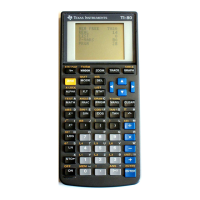For
x
4
−x
3
+8x
2
−6x+7
(
x−1
)(
x
2
+2
)
2
use expand((x^4-x^3+8*x^2-6*x+7)/((x-z)*(x^2+x)^2))
which returns
−1
x
2
+2
+
3x
(
x
2
+2
)
2
−
1
(
x
2
+2
)
2
+
1
x−1
[2.17] Use a 'clean' or empty folder for CAS operations
Results from symbolic operations may not be correct if values are already defined for the variables in
your expression. However, you might not want to delete the variables in the folder in which you are
working.
One solution to this problem is to create an empty directory specifically for performing symbolic
manipulations. If you define no variables in this folder, symbolic operations will always be performed
assuming all the variables are undefined, which is usually what you want.
If you name this folder something like aaa, it will always be at the top of the list displayed by Current
Folder in the Mode menus, and you can quickly switch to it.
To use the folder, make it current with the Mode key or setfold() command. Perform the CAS
operations as needed.
[2.18] Delay evaluation to simplify expressions
Sometimes the CAS will not simplify expressions because it assumes general conditions for the
variables. As an example, suppose that we have the expression
t
n
and we want to extract the exponent n. We could try using the identity
n =
ln(t
n
)
ln(t)
but the CAS will not simplify the right-hand expression to n, because this expression is undefined for
t=0, and because this identity is not generally true for t<0. So, if we constrain the expression for t>0,
like this
ln(t^n)/(ln(t))|t>0
the CAS returns 'n' as expected. While this example had a fairly simple solution, you may want to use
this technique for more complex expressions in which the constraints are not immediately obvious. In
addition, you may need to apply the constraints sequentially to get the desired result. To continue with
the same example, suppose that we want to use the constraints
t=p^2 and n=q^2
This will result in the desired simplification, since
ln(t^n)/(ln(t))|t=p^2 and n=q^2
2 - 10

